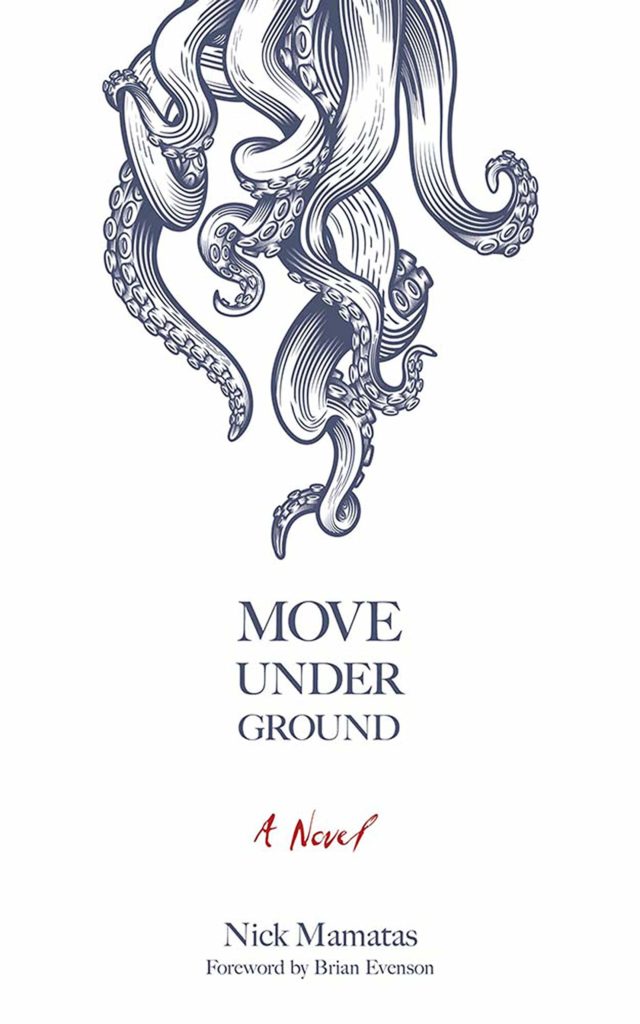
When it comes to literary techniques, pastiche can be one of the most subtly volatile out there. Most of the time when it’s utilized, it’s effectively invisible — effectively cloaking an author’s work in the voice of another. When it’s done badly, it can be utterly unbearable; I’ve still never been able to make it through the segment of The League of Extraordinary Gentlemen: Black Dossier in which Alan Moore channels Jack Kerouac. There’s something about Cthulthu mythos stories that brings pastiche to the foreground — there’s a Lovecraftian Wodehouse pastiche in the aforementioned Black Dossier, for instance, and it’s far from the only one.
Neil Gaiman’s short story “A Study in Emerald” is one such example of a Lovecraftian pastiche — in this case, of the Sherlock Holmes stories — that works brilliantly. So too is Nick Mamatas’s recently-reissued Move Under Ground, which brings together two seemingly disparate literary traditions into one seamless whole. Effectively speaking, this is the Beats versus the Elder Gods — and while that can sound bizarre on paper, Mamatas embraces the seemingly contradictory elements of the premise and pushes it towards some compelling yet uncomfortable places.
The plot of Move Under Ground is simple: Jack Kerouac becomes aware of the rise of Lovecraftian beings in 1960s America, where their presence heralds a rise in conformity and a society less amenable to art. William Burroughs and Neal Cassady join Kerouac in working to stop this intrusion from sinister forces — but the novel also abounds with betrayals and reversals. In his introduction to this edition, Brian Evenson argues convincingly that Move Under Ground can be read as a critique of the Beats along with its more straightforward elements.
Some of the ways in which Evenson brings together two seemingly disparate literary modes are thrilling in and of themselves. The Beats wrote about ecstatic and transformative states; built into the Mythos tales is a sense of spatial relations decaying and transforming into something bizarre. Smash the two together and you end up with hallucinatory passages like this one:
The earth contracted, then expanded again like the belly of a fat and snoring old hobo under a leaky roof. We drove half-blind through Utah, the few miles there were left of it, driving even through the steam that billowed from the red-hot hood of Neal’s jalopy. The state was a horrible void of clapboard towns we flew past, cracked alkali flats and squirming horrors only we could see above.
There’s also the elephant in the room (or, in this case, the shoggoth in the room) when alluding to Lovecraft, which is to say the racism that pervades many of his stories. Mamatas doesn’t take the same approach here that, say, Victor LaValle did in The Ballad of Black Tom — but he does figure out a distinctive way to reckon with toxic systems of belief.
Move Under Ground moves at a brisk and madcap pace, but it’s also willing to head into some uncomfortable territory. To reveal just what this book has in store for its protagonist would be telling, but I was left reeling at how searing its final pages were — and how it left me reconsidering what had come before. Call this pastiche if you like, or call it homage — but whatever name you affix to it, it’s both gripping and thought-provoking in unexpected ways.
***
Move Under Ground
by Nick Mamatas; introduction by Brian Evenson
Dover Publications; 176 p.
Follow Vol. 1 Brooklyn on Twitter, Facebook, and sign up for our mailing list.
